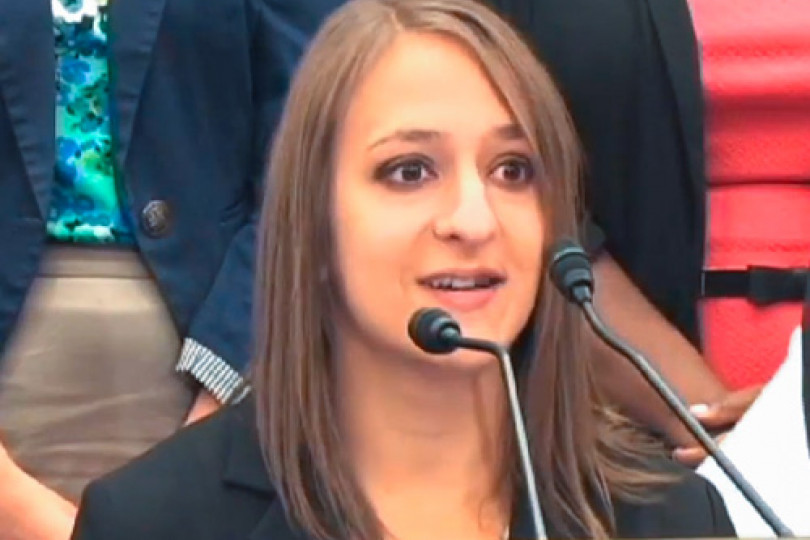Lisa Suda’s comments during the press conference referred to in this story can be viewed on YouTube or in the video below beginning at the 21 minute 10 second mark.
Daughter of L-7 member speaks out about high cost of higher education
IT WAS SUPPOSED to be a dream come true for Lisa Suda, daughter of Local 7 (Buffalo, N.Y.) member Douglas Suda. Lisa was accepted into American University in Washington, D.C., in 2007, a private college ranked in the top 100 nationally. Four years later, she graduated with a Bachelor of Arts in Political Science/American Government with a minor in American Studies.
She was ready to start a promising new career as a congressional staff assistant.
But Lisa left the university with more than a degree. She took with her a financial burden of more than $140,000 in private loans, fees and interest. Her level of debt is extreme, due in part to unfortunate circumstances.
Lisa had entered college with an array of financial support: educational grants, a federal work-study program and merit scholarships, including one from the Boilermakers union. Private loans and family support accounted for the rest of her obligations.
But then her father retired early due to disabilities incurred by years of field construction work. A one-time Social Security payment of $10,000 temporarily bumped up the family’s income and disqualified Lisa from the work-study program in her sophomore year. She borrowed again to cover her second year and twice more to complete her college education.
Forty million Americans collectively owe $1.2 trillion in student debt.
Upon graduation, her dream career gave way to a harsh reality: entry-level congressional staffers are not paid enough to cover living expenses plus $1,400 a month in student loans.
Instead, she went to work for a commercial real estate company.
Student debt crisis affects 40 million Americans
LISA IS ONE of 40 million Americans who collectively owe a staggering $1.2 trillion in student debt today. Seven million Americans have already defaulted.
According to the Pew Research Center, 37 percent of households headed by an adult younger than 40 currently have some student debt. That’s the highest percentage on record.
A December 2013 report by the Project on Student Debt found that seven in 10 college seniors who graduated in 2012 faced an average student loan debt of $29,400. Moreover, the report said, “The national share of seniors graduating with loans rose in recent years, from 68 percent in 2008 to 71 percent in 2012.”
Political leaders have struggled to get a handle on the crisis, with little success. Loan caps, tax exemptions, loan forgiveness — even allowing student loan bankruptcies — have been debated or proposed.
On July 25, Lisa found herself in the middle of the student debt debate on Capitol Hill. A friend had asked if she would be willing to speak at a press conference hosted by House Democratic leaders promoting the Bank on Students Emergency Loan Refinancing Act (HR 4582). The act would fix interest rates at 4 percent, less than half the rate Lisa is currently paying.
Lisa was told that event organizers wanted to hear from a person with a blue-collar background, so she accepted the invitation. The very next morning she stood at a microphone in the midst of House Minority Leader Nancy Pelosi (CA), Rep. George Miller (CA), Rep. John Tierney (MA), Rep. Donna Edwards (MD) and Rep Joaquin Castro (TX).
Lisa spoke passionately and personally about her blue-collar roots, which include three generations of Boilermakers (her grandfather, father and a brother).
She talked about how those who don’t come from high-income families should be able to attend the college of their dreams. And she left no doubt about the worry and anxiety she faces every day under the mountain of debt that hangs over her.
Broken dreams and lessons learned
TODAY, AT AGE 25, Lisa works for a large D.C.-area law firm as a legal secretary. The job, like her previous one in commercial real estate, is not a perfect fit with her college degree, but it pays the bills. Over the last two years, Lisa says she has paid nearly $30,000 in interest on student loans.
Looking back, she admits to being naïve about what the end cost of higher education could mean for her. She knows she is not alone, that millions of Americans are struggling with paying down student debt instead of focusing on the dreams that led them to attend college in the first place.
She expresses hope that by speaking out at the July 25 press conference she has at least put a human face on a colossal problem.






